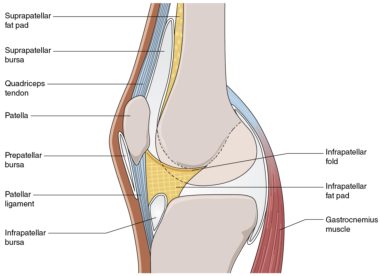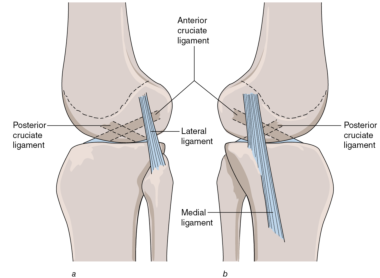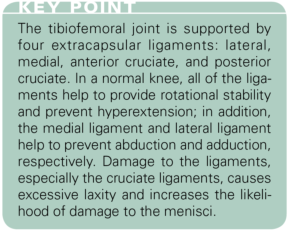Structure of the knee facilitates extension and flexion
This is an excerpt from Structure and Function of the Musculoskeletal System - 2E by James Watkins.
Capsule of the Knee
The tibiofemoral and patellofemoral joints share a common capsule that has a complicated shape. The capsule is attached above to the femur, below to the tibia, and anteriorly to the patella (figure 6.13). To accommodate the extremes of full flexion and full extension of the tibiofemoral joint, the anterior part of the capsule is folded upward during extension and the posterior part of the capsule is folded downward during flexion. The upward fold, only present in extension, is referred to as the suprapatellar bursa (figure 6.13). The suprapatellar bursa intervenes between the quadriceps tendon and the anterior aspect of the femur just proximal to the patellar surface.

Figure 6.13 Sagittal section through the knee complex showing the shape of the capsule in extension.
The downward fold, only present during flexion, is referred to as the gastrocnemius bursa. The gastrocnemius bursa intervenes between the posterior aspect of the tibial condyles and the gastrocnemius muscle. In general, a bursa is a flattened sac of synovial membrane containing synovial fluid. Bursas minimize friction between structures that slide across each other during normal movement (see chapter 7).
During flexion of the tibiofemoral joint, the suprapatellar bursa becomes progressively smaller and the gastrocnemius bursa becomes progressively larger as synovial fluid is redistributed from the suprapatellar bursa to the gastrocnemius bursa. The movement of synovial fluid is reversed during extension of the tibiofemoral joint; that is, the gastrocnemius bursa becomes progressively smaller and the suprapatellar bursa becomes progressively larger.
The suprapatellar bursa is separated from the femur by a pad of fat called the suprapatellar fat pad. Lying in the space bounded by the upper two thirds of the posterior aspect of the patellar ligament, the anterior intercondylar area of the tibia, and the anterior inferior aspect of the articular surface of the femoral condyles is a pad of fat called the infrapatellar fat pad. It is roughly triangular in sagittal cross section and is suspended superiorly from a fibro-adipose band called the infrapatellar fold. The infrapatellar fold is attached anteriorly to the inferior pole of the patella and posteriorly to the anterior border of the intercondylar notch (figure 6.13). The infrapatellar fat pad is attached anteriorly to the posterior aspect of the patellar ligament and extends at both sides of the patellar ligament. The infrapatellar fat pad also extends narrow branches halfway up each side of the patella; the branches are referred to as alar folds (alar = winglike). The infrapatellar fat pad cushions the patellar ligament and lower part of the patella during movements of the knee.
Knee Ligaments
Four extracapsular ligaments support the tibiofemoral joint. The lateral ligament (also referred to as the lateral collateral ligament and the fibular collateral ligament) is attached superiorly to the lateral epicondyle of the femur and inferiorly to the head of the fibula (figure 6.14a). The medial ligament (also referred to as the medial collateral ligament and the tibial collateral ligament) is attached superiorly to the medial epicondyle of the femur and inferiorly to the medial aspect of the tibia below the tibial condyle (figure 6.14b). The posterior fibers of the medial ligament blend with the joint capsule at the level of the medial meniscus and thus the medial ligament is not completely extracapsular. The arrangement of the medial and lateral ligaments and the curvature of the femoral condyles are such that both ligaments are relatively slack when the knee is flexed but become progressively more taut as the joint extends. In a normal joint the ligaments are fully taut when the joint is fully extended. In this position of the joint both ligaments help to prevent hyperextension and lateral rotation of the tibia relative to the femur. With the knee fully extended, the range of abduction and adduction is normally zero. Because the medial and lateral ligaments are relatively slack when the knee is flexed, a certain amount of axial rotation and abduction and adduction of the lower leg can occur when the knee is in a flexed, non-weight-bearing position. For example, when a person is sitting on a table with his lower leg hanging freely, the ranges of internal and external rotation are normally around 30° and 40°, respectively (Norkin and Levangie 1992). However, the ranges of abduction and adduction are normally very small, approximately 2° to 5°.

Figure 6.14 Location of the main ligaments of the left knee. (a) Lateral aspect. (b) Medial aspect.
Injuries to the lateral and, in particular, the medial ligaments are common in sports (Reider 1996). The classic cause of medial ligament injury is a blow to the lateral aspect of the knee while the foot in contact with the ground, resulting in abduction of the knee. This situation is common in sports such as American football, soccer, and rugby. The excessive loading on the medial ligament in such situations can result in serious injury (Indelicato 1995). Medial ligament injuries of a less severe but nonetheless persistent nature are common in swimmers, especially breaststroke swimmers. The whip-kick leg action in breaststroke tends to simultaneously abduct and laterally rotate (tibia with respect to femur) the knee, resulting in strain of the medial ligament and associated medial supporting structures (Vizsolyi et al 1987).

SHOP

Get the latest insights with regular newsletters, plus periodic product information and special insider offers.
JOIN NOW


